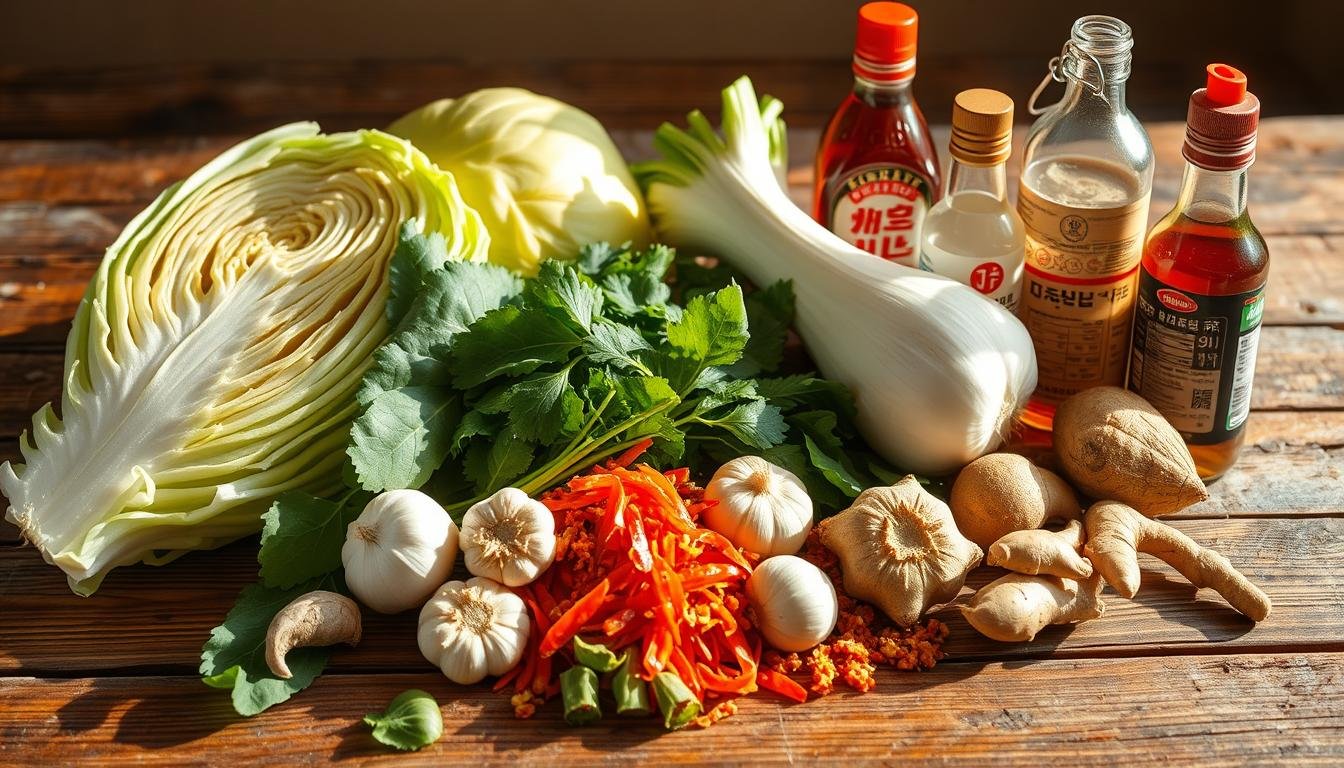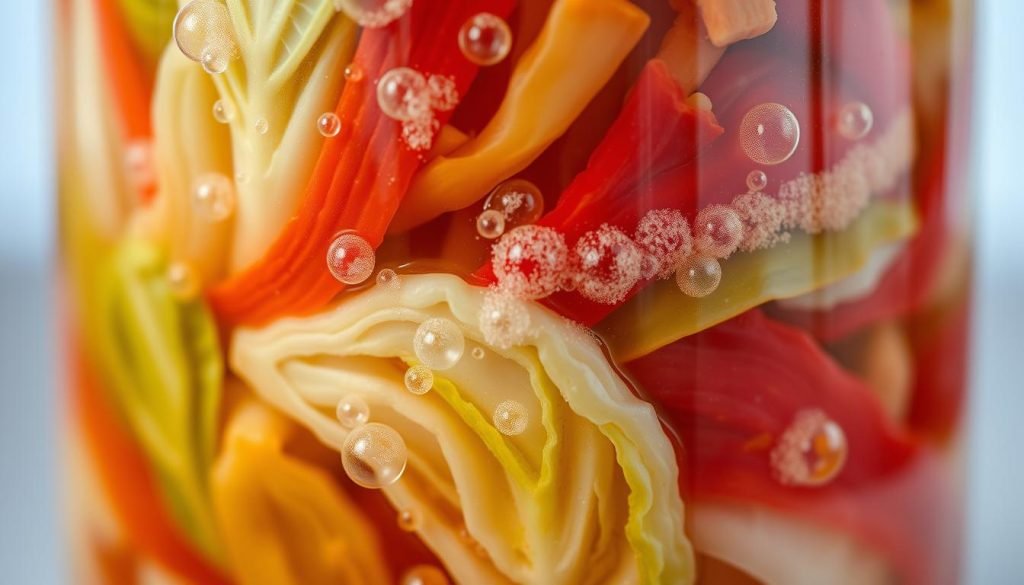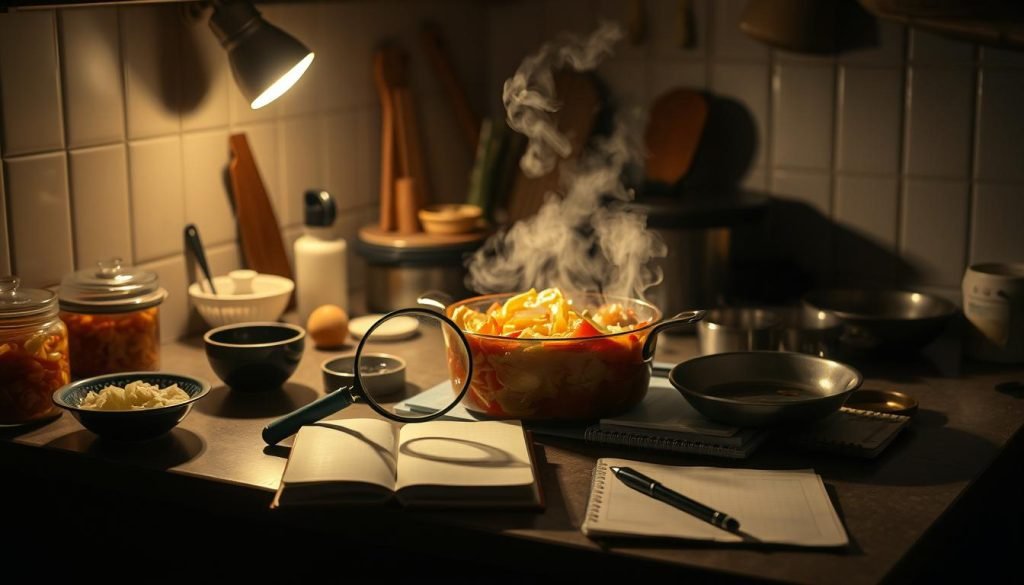Homemade Kimchi Recipe (Easy Guide)

Have you thought about how a simple side dish can add flavor and health benefits? This easy kimchi recipe is a key part of Korean food. It’s also full of probiotics that can help your digestion and immune system.
Kimchi is known as one of the healthiest Korean foods. It’s made by fermenting vegetables, turning them into a mix of flavors. With over 19 million views on YouTube, many love making homemade kimchi. This guide will show you the basics, like what ingredients to use and how to make it.
Are you ready to start making this dish that people all over the world love? Let’s explore the world of homemade kimchi together!
What is Kimchi?
Kimchi is a key part of Korean food, loved for its taste and health perks. It’s made from veggies like napa cabbage and Korean radish, salted and fermented. For over 2,000 years, kimchi has been a staple, changing with local tastes.
Origin and History
The making of kimchi, called kimjang, once united people. Folks would come together to make kimchi, building community and culture. In the 19th century, chili peppers from the Americas made kimchi spicy.
A 2001 rule said kimchi must have salted napa cabbage and spices like gochugaru, garlic, and ginger.
Health Benefits
Kimchi’s making process boosts its health value, making it full of good bacteria. These bacteria help your gut and immune system. Eating kimchi regularly can improve digestion and give you important vitamins A, B, and C.
It’s also low in calories and high in fiber, helping control blood sugar and weight. Adding kimchi to your meals brings flavor and health benefits.

Essential Ingredients for Kimchi
To make great kimchi, knowing the key ingredients is important. You need fresh veggies, special spices, and more. This mix makes kimchi taste amazing. It’s perfect for enjoying healthy Korean food at home.
Types of Vegetables Used
Napa cabbage is the main veggie in kimchi. It soaks up flavors well. You’ll need about 6 pounds of napa cabbage to make 8 pounds of kimchi.
Korean radish, or daikon, adds crunch and a bit of spice. Use about 2 cups of matchsticks. Carrots and green onions (7 to 8 stalks) also add flavor and look. You can add Asian chives or water dropwort for more taste.
Unique Spices and Seasonings
Gochugaru (Korean red chili pepper flakes) is key for kimchi’s taste. Use about 2 cups. It gives kimchi its bright color and heat.
Fish sauce (½ cup) and garlic (about 24 cloves) add depth. Fresh ginger (2 teaspoons) makes it aromatic. A bit of sugar helps with fermentation and balances the spice.
Additional Ingredients
There are more ingredients to try in kimchi. Fermented shrimp (¼ cup) adds depth. Korean plum extract gives it a sweet touch that helps with digestion.
Fruits like Asian pear or apples can also make your kimchi special. Try different things to make your kimchi unique. It’s a fun way to explore flavors.

Tools You Will Need
To make homemade kimchi, you need the right tools. Each tool is important for making your spicy food just right. Here are the main tools you’ll need to start.
Fermentation Jar
A fermentation jar is key for making kimchi. It needs to be big enough for all your ingredients. This lets them expand during fermentation. Choose a jar that’s airtight and won’t react with your food. The right jar helps your kimchi ferment well and taste great.
Measuring Cups and Spoons
Using measuring tools accurately is crucial. Each ingredient is important for your kimchi’s taste and texture. Good measuring cups and spoons help you make the recipe right. This means using the right amount of chili flakes or salt.
Gloves (Optional)
You can make kimchi without gloves, but they help. Gloves for handling protect your skin from chili flakes. Spicy foods can hurt your skin. So, wearing gloves keeps you clean and comfortable, even when handling garlic and ginger.

| Tool | Description | Importance |
|---|---|---|
| Fermentation Jar | Spacious, airtight container | Essential for proper fermentation |
| Measuring Tools | Cups and spoons for precise measurements | Ensures accurate ingredient proportions |
| Gloves | Optional; protect hands from spiciness | Enhances hygiene during preparation |
Preparing Your Vegetables
Getting your veggies ready is key to making tasty homemade kimchi. Start by cleaning them well to get rid of dirt. This makes sure your veggies are ready for the fermentation process.
Napa cabbage is a main ingredient. You need to wash it well and cut it into the right size. This helps with even salting and fermentation.
Washing and Cutting
First, clean veggies like Napa cabbage, green onions, carrots, and daikon radish. Here’s how to cut them:
- Napa Cabbage: Cut the cabbage into quarters, then slice it into bite-sized pieces.
- Carrots: Finely grate or julienne for an even distribution throughout the kimchi.
- Daikon Radish: Coarsely grate to release its natural flavors.
- Green Onions: Chop into 1-inch pieces for added crunch.
Proper cutting makes your kimchi taste better and feel right.
Salt Brining Techniques
Salt brining is important for getting moisture out of veggies. This starts the fermentation process. Here’s how to do it right:
- Sprinkle about 1 teaspoon of salt on each veggie and let it sit for 20 minutes.
- Massage the salt into the veggies to get moisture out faster.
- Drain off any extra liquid before mixing the veggies in your kimchi.
Salt is key for fermentation. Too little salt can cause mold. Too much can stop good bacteria. Finding the right balance makes your kimchi taste great.
Making the Kimchi Paste
Making the perfect kimchi paste is all about mixing ingredients right. Start with gochugaru, the Korean red chili flakes that make kimchi spicy. You’ll need 1 cup of gochugaru, a ½ medium onion, ½ Korean pear, 30g of ginger, and 1 clove of garlic.
Add wet ingredients like ½ cup of fish sauce and ¼ cup of shrimp paste. These add deep flavors.
Mixing Ingredients
To get the right texture of kimchi paste, blend dry and wet parts well. Add ¼ cup of glutinous rice flour mixed with 2 cups of water, cooked into a paste. This makes the paste creamy and sticks to veggies.
Mix well for even flavors. Taste and adjust with more fish sauce or gochugaru if needed.
Achieving the Right Consistency
The consistency of your kimchi paste is crucial. It should be thick but spreadable, sticking to napa cabbage leaves well. If it’s too thick, add a bit of water. If too runny, add more rice flour.
Check if it coats a vegetable evenly without dripping. This is the right consistency.

Take your time with this step. The taste and texture of your kimchi paste will make your homemade kimchi.
Combining the Ingredients
Making tasty kimchi needs careful mixing of ingredients. You must layer them well. This makes sure flavors mix right and the paste coats all veggies evenly. Every step makes the taste better, so you enjoy every bite.
Layering Techniques
Layering right is key for great kimchi. Here are some tips:
- Begin with napa cabbage as the base. It holds lots of other ingredients.
- Then, mix shredded daikon radish, grated carrot, and red radishes. They add crunch and color.
- Add green onions and garlic in between. This spreads their flavors well.
- Make sure to layer in a pattern. This helps distribute everything evenly.
Ensuring Even Coating
To coat everything evenly with kimchi paste, use your hands or a tool. Here’s how:
- Spread the paste over each veggie gently but firmly.
- Fold the ingredients to make sure the paste covers all. This helps flavors soak in during fermentation.
- Break up any clumps of paste. This ensures even coating.
A well-coated kimchi has better flavor mixing. It tastes zesty and fresh during fermentation. Paying attention to layering and coating makes your kimchi taste amazing.

Fermentation Process
Learning about fermentation is key to making tasty homemade kimchi. The place where you ferment your kimchi affects its taste and feel. The right temperature and timing are crucial for good fermentation. This lets you enjoy the special flavors that come out.
Ideal Temperature and Time
The fermentation process needs the right conditions for good bacteria, like lactobacilli, to grow. Here’s how temperature affects how long it takes to ferment:
| Temperature (°F) | Time to Ideal Fermentation (Days) | Outcome |
|---|---|---|
| 39 | 22 | Mold growth within a week; mostly Leuconostoc species |
| 50 | 14+ | Mixture of Leuconostoc and Lactobacillus species |
| 65 | 9 | Preferred taste; predominantly Lactobacillus species |
| 70 | 6 | Overly effervescent and mushy |
The best temperature for flavor is between 50 and 70 degrees Fahrenheit. Around 65 degrees is perfect for flavor. But, stay away from temperatures over 85 degrees to avoid bad bacteria.
Signs of Successful Fermentation
Knowing when your kimchi is ready is important. Look for these signs:
- Bubbling in the jar, showing gas from fermentation
- Sour smells from lactic acid
- Texture changes, like softer cabbage and deeper flavors
- A pH of about 4.5, usually after two weeks
Watching for these signs means you can enjoy your homemade kimchi. It’s a traditional treat that’s also good for your health.

Storing Your Kimchi
Keeping your homemade kimchi fresh is key. The right storage and fridge techniques are crucial. You need the best containers to keep it tasty for months.
Best Containers for Storage
Choosing the right kimchi containers is important. Look for airtight, non-reactive materials like glass or food-grade plastic. These keep your kimchi fresh longer. Here are some good choices:
- Airtight glass jars: Great for keeping air out and flavors in.
- Food-grade plastic containers: Easy to carry and practical.
- Fermentation lids: Let gases out while keeping everything sealed.
Using a clean container helps your kimchi last longer. Make sure it’s sealed tight to avoid contamination.
How to Refrigerate for Freshness
Refrigerate your kimchi at 4 degrees Celsius or lower. This slows down fermentation, making it last 3-6 months. Here’s how to keep it fresh:
- Opened kimchi stays fresh for a week at room temperature.
- After refrigeration, eat it within 3 months for the best taste and crunch. It’s still safe for another 3 months but might lose some texture.
- Keep it tidy in your fridge to keep the temperature even.
White spots on kimchi are usually harmless yeast, not mold. But if it smells bad or has mold, throw it away. Fermentation in the fridge can make your kimchi taste better over time.

Ways to Enjoy Kimchi
Kimchi is more than a side dish. It makes many meals better. You can find it in Korean dishes and in new recipes. Try kimchi jjigae and kimchi fried rice for a taste of its unique flavors.
These dishes show how kimchi can add excitement to your meals. Let’s look at how to use kimchi in your daily cooking.
Traditional Dishes Using Kimchi
Kimchi is key in Korean food. Here are some dishes that show its importance:
- Kimchi Jjigae: A hearty stew with pork, tofu, and kimchi. It’s very comforting.
- Kimchi Fried Rice: Ready in 15 minutes, it’s great for lunch or dinner.
- Tofu Kimchi: A classic appetizer, loved with drinks in Korea.
- Kimchi Pancakes: Crispy and served with sauce, they’re a joy to eat.
- Kimchi Udon: A fast 15-minute recipe with udon noodles and kimchi flavors.
Creative Recipes with Kimchi
Kimchi can also be used in new and exciting ways:
- Kimchi Rice Bowls: Ready in 10 minutes, they’re quick and healthy.
- Spicy Cold Kimchi Noodles: A cool dish perfect for summer.
- Kimchi Pizza: Add kimchi to pizza for a unique taste.
- Kimchi Spaghetti: This dish has creamy mushrooms, crispy bacon, and gochujang.
- Ham and Egg Cups with Kimchi: A quick meal for any time.

Start your day with kimchi in breakfast tacos. Add kimchi to steamed rice for spice. Use kimchi liquid in dips and dressings. These ideas show how to enjoy kimchi in new ways.
Troubleshooting Common Issues
Making homemade kimchi is fun, but sometimes problems can happen. These issues can change how your kimchi tastes and feels. This part will help you fix common problems to make your kimchi better.
Taste Not Right? What to Do
If your kimchi doesn’t taste right, it might need some tweaks. Changing the flavor can really help. Here are some tips to make your kimchi taste better:
- Add More Salt: More salt can make it taste better.
- Incorporate Spices: A little garlic powder or chili flakes can add flavor.
- Sweeten It Up: A bit of sugar or sweet juice can balance it out.
- Experiment: Keep tasting it to know when to make changes.
Texture Concerns and Fixes
Texture problems can happen when making kimchi. It might be too soft or too hard. Here are some ways to fix texture issues:
- Remove Excess Moisture: If it’s too wet, drain it before putting it in the jar.
- Ensure Proper Brining: Brine the veggies long enough to get the right firmness.
- Monitor Fermentation Time: Too long can make it soft; watch the time.
- Use Fresh Ingredients: Choose crisp, fresh veggies to avoid texture problems.

By using these tips, you can make your kimchi taste and feel great. This way, you’ll have delicious homemade kimchi every time.
| Problem | Possible Cause | Solution |
|---|---|---|
| Bland Taste | Insufficient salt or spices | Add salt, garlic powder, or chili flakes |
| Too Sour | Over-fermentation | Add sugar or sweet fruit juice |
| Mushy Texture | Excess moisture or too long fermentation | Drain before sealing and monitor fermentation time |
| Crunchy Texture | Inadequate brining | Ensure proper brining techniques and use fresh ingredients |
Frequently Asked Questions About Kimchi
Kimchi is a versatile dish that many love. People often ask about using different vegetables in their recipes. You can make your kimchi unique by using various vegetables.
Try using radishes, cucumbers, lettuce, and green onions. There are about 100 types of kimchi you can try. This lets you show off your own taste.
Can I Use Different Vegetables?
Trying different vegetables can make your kimchi taste and feel amazing. Some veggies add special tastes and crunchiness. It’s fun to mix things up and make each batch special.
How Long Does Kimchi Last?
Knowing how long kimchi lasts is key to enjoying it. Most store-bought kimchi stays good for up to six months. It’s best kept at 30-40°F.
As time goes by, the taste might change, and the cabbage can get softer. Look for kimchi with an “Enjoy By” date at least five months ahead. This ensures it’s fermented well and full of flavor.